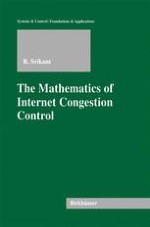2004 | OriginalPaper | Chapter
Conclusions
Author : R. Srikant
Published in: The Mathematics of Internet Congestion Control
Publisher: Birkhäuser Boston
Included in: Professional Book Archive
Activate our intelligent search to find suitable subject content or patents.
Select sections of text to find matching patents with Artificial Intelligence. powered by
Select sections of text to find additional relevant content using AI-assisted search. powered by
In this book, we have summarized the exciting advances in the field of mathematical modelling of Internet congestion control over the last few years. As mentioned in the Introduction, this subject is vast and we have confined our attention to only those topics that lead to simple, decentralized schemes. We have concentrated our attention on algorithms that directly result from a convex programming view of congestion control as a mechanism for resource allocation. While this viewpoint is sufficiently rich in allowing us to model many practical aspects of window-flow control as implemented in the Internet, it does not address two important algorithms implemented within TCP, namely, slow start and timeout. For practical implementation of any congestion controller, the slow-start phase and a timeout mechanism are important and are worth further study. We have also not characterized the robustness of virtual queue-based marking mechanisms in this book. Compared to marking based on the contents of the real-queue, virtual-queue-based marking has many advantages. The reader is referred to [32, 31, 51, 66] for an analysis of the properties of virtual-queue-based congestion feedback. Another important problem not discussed in this book is the development of algorithms to limit the impact of users who do not obey congestion signals on the users who reduce their rates in response to congestion feedback from the network. This problem has been addressed in [86, 85, 24].
